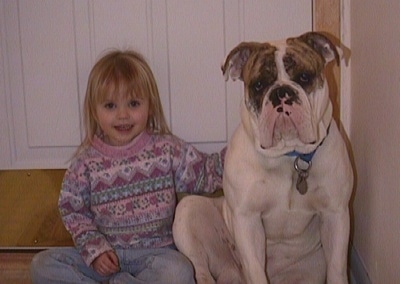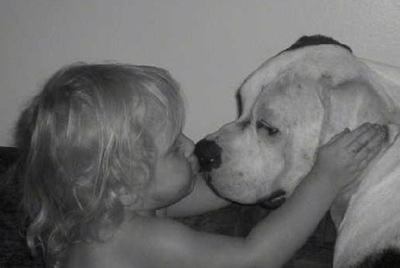
When you bring home a new baby you are adding a new member to your pack. You need to learn how to create that special bond between baby and dog. It is important not to shut your dog out when the new baby comes home. Include the dog in your pack, and try and keep the same routine you usually have with the dog. Dogs need to be taught to give the baby space and respect, especially during feeding time. The baby needs to be seen as above the dog in the pack order, yet feel like it is still part of your pack.
"This is my American Bulldog Trinity (1 year) and my son (6 months). She keeps a watchful eye on him and does everything at half-speed when he is near. They love each other very much."
Preparations for the new baby should start before the baby is brought home. Work on getting all dogs in your home balanced and well-trained. This should start as soon as possible. Everyone in the family should educate themselves on Understanding Dog Behavior. You want your dog to be calm and submissive.
I am often asked if becoming a dog’s 100% pack leader and having a submissive dog prevents a dog from being a good guard or watch dog. No, all members of the pack, even lower members will step up and protect the rest of the pack should the need arise. You cannot train the guard out of a guard dog or take the keen senses out of a watch dog, but you can have it respect, and listen to your commands happily. You do not want the dog to own the baby, own you, or your home.

All dogs need boundaries inside the home. It is a good idea to set the baby room as one of those boundaries. As soon as you know what room will be your nursery stop allowing your dog into that room. Not by simply closing the door, but by leaving the door open and not allowing the dog to enter. Teach the dog that is not its place. This way when the baby does come home you will be sending a signal to the dog that the baby is higher in the order, as the baby will be allowed into a room in which it is not.
It is OK for a dog to be up on the furniture if you are the one inviting it up. However you must be aware that in the dog world, the pack leader sleeps and rests in the most comfortable spot. If you are going to allow your dog up on the beds and couch make sure it is at times you invite it. Take extra care to insure the dog is not pushing you out of the spot or owning the furniture. Think about whether or not you are going to want a dog jumping up onto the furniture when you have a baby in your arms, or a bassinet seat that might be placed on a couch. If the answer is no and you are not going to want a dog jumping up where your baby might be, start training your dog to stay down preferably before the baby comes home. Unless you are very familiar with a dog's body language and signs of dominance and are always aware of it, it is recommended the dog has a comfortable place to sleep on the floor rather than be allowed to jump up on your furniture. It is very easy for a dog to begin to believe it owns your furniture, including the bed.
I cannot stress enough how important daily exercise, in the form of a pack walk, is to the stability of a dog, both mental and physical. Before the baby comes home, make sure your dog heels on a lead. This is a very important human to dog communication; pack leader goes first. When you allow your dog to walk ahead of you or enter and exit door and gateways before you, you are communicating to the dog that it is before you in the order. Teach your dog to follow YOU rather than you following IT.
Therefore, you must also teach the dog to walk beside or behind the stroller, not in front. If you wish you can practice this with an empty stroller before the baby comes home. Get the dog used to walking with a stroller. If you cannot make your dog heel it is time to work on perfecting your walk. You want your dog to be following your baby, not leading your baby. If you allow your dog to walk ahead of the stroller you will be communicating to the dog that it is above your baby in the pack order. Going for a pack walk with your baby and the dog is a great way to help establish the baby's alpha position and strengthen the bond within your pack.
After the baby is born, but before the baby comes home from the hospital have someone bring an object containing the baby's scent to the dog. Place the object on the floor and tell your dog to leave it. Only allow the dog to smell it from a distance. The dog should be close enough to smell it, but do not allow him to touch it; keep a reasonable distance. Make the dog give the object space. After you have established this space with your dog you can pick the object up and allow the dog to smell it a little closer while you hold the object, but again, do not allow the dog to touch it. That scent is not going to be something they are going to be allowed to own. The scent needs to be associated with space and respect.

The day the baby comes home have someone walk the dog to drain its energy. I realize times are very busy when babies are born, however do not neglect the needs of your dog. Do your best to arrange for it to still receive its pack walk. An extra-long walk the day the baby comes home is ideal to insure it is calm when the baby comes through the door.
You do not want the dog to associate the baby with negative emotions. Therefore make sure you are feeling confident. Deal with the dog in a firm but calm manner. Refrain from becoming angry, anxious, nervous, or any other negative emotion. The dog is part of the pack too. It just has to be lower in the pack order than the baby and all other humans. When that is clear and its exercise needs are fulfilled it will be happy.

Do not let your dog rush, crowd or jump on the person holding the baby. If your dog normally does this you need to work on this issue before the baby comes home. Dogs that are respectful give space to their pack leaders. A subordinate dog would never dream of jumping up on its pack leader in that manner.
Do not allow the dog to immediately get its nose on the baby. A dog's senses are keen and it can smell the baby from a reasonable distance. Boundaries need to be established. You do not want the dog to, in its mind, claim the baby as its own. If you allow the dog to immediately get its nose into the baby and smell them and touch them there is a chance your dog will be doing just that—claiming the new pack member as its own.

The dog should always give space to whoever is holding the baby. Do not allow the dog to push you out of the way or nose its way onto you while you have the baby in your arms, especially at feeding time. A subordinate dog would never dream of invading the privacy of a mother dam and her puppies. Do not allow your dog to invade your space. Do not mistake the dog’s attempts at owning as jealousy or a gesture of love. Correct any anxious barking or whining. Communicate to the dog that you will handle the issues with the baby, it is not the dog’s place. Read more about the signs of dominance in dogs and pay very close attention to your dog to ensure it is not showing any of these signs.

This picture shows the first meeting between two dogs and a new baby. The dogs are respecting the new baby and their owner, shown by the way the Beagle mix is lying down in a very calm, submissive state. She is relaxed and is communicating to the owner that she is not trying to take over or claim. The Pit Bull mix in the back is showing ultimate respect by not only giving space, but also turning her back to the person holding the baby, and soon after leaving altogether.

Neither of these dogs are showing any signs of wanting to own the new pack member, but rather are showing signs of acceptance. The owner is standing in the baby's room, which the dogs have been told they cannot go in. This is an excellent way to help relay the message to your dog that the baby is higher in the pack order. In addition, the dogs were taken for a very long pack walk before the baby was brought into the home to help keep them in a calm, submissive state. The owners made it a point to not have any excitable guests over who did not understand dog behavior during this first meeting between dogs and baby. The owners also worked very hard at communicating to the dogs that humans were higher in the pack order before the baby was born. All the hard work was proven to have paid off, and the owners know they will need to continue to show leadership and provide daily exercise to keep their pack balanced.
Ten months later Maggie the Pit Bull mix and Darley the Beagle mix are submissive to the 10-month-old baby in different ways. Maggie will let the baby touch her and in this video she rolls over for him. Darley, on the other hand, gives up space and avoids him.
Here is another video clip showing a very good example of a dog that is not only calm and balanced in his mind, but submissive and happy. Spencer the 14-month-old American Pit Bull Terrier meets a 14-month-old baby for the first time. Spencer has seen babies from a distance but this was the first time he was this close. Right from the start we set the boundaries with Spencer: be calm and no licking or being too pushy, respect the baby's space. It was as if Spencer the Pit Bull grew up with babies all his life. He was excellent with the baby. Bruno the Boxer was still recovering from his ACL surgery and was restricted to his x-pen, but he loved the baby too.

Be consistent with your dog at all times. Do not neglect its exercise needs. Keep its energy drained and always be your dog's calm, firm, confident pack leader. All family members must be on board with showing leadership and providing exercise. Be sure to teach your children to also respect the dog and proper dog handling. Never leave a small child alone with a dog. Doing this will insure a safe, respectful, strong bond between baby and dog for years to come.

"Courtney, giving our American Bulldog, Gauge, a kiss."